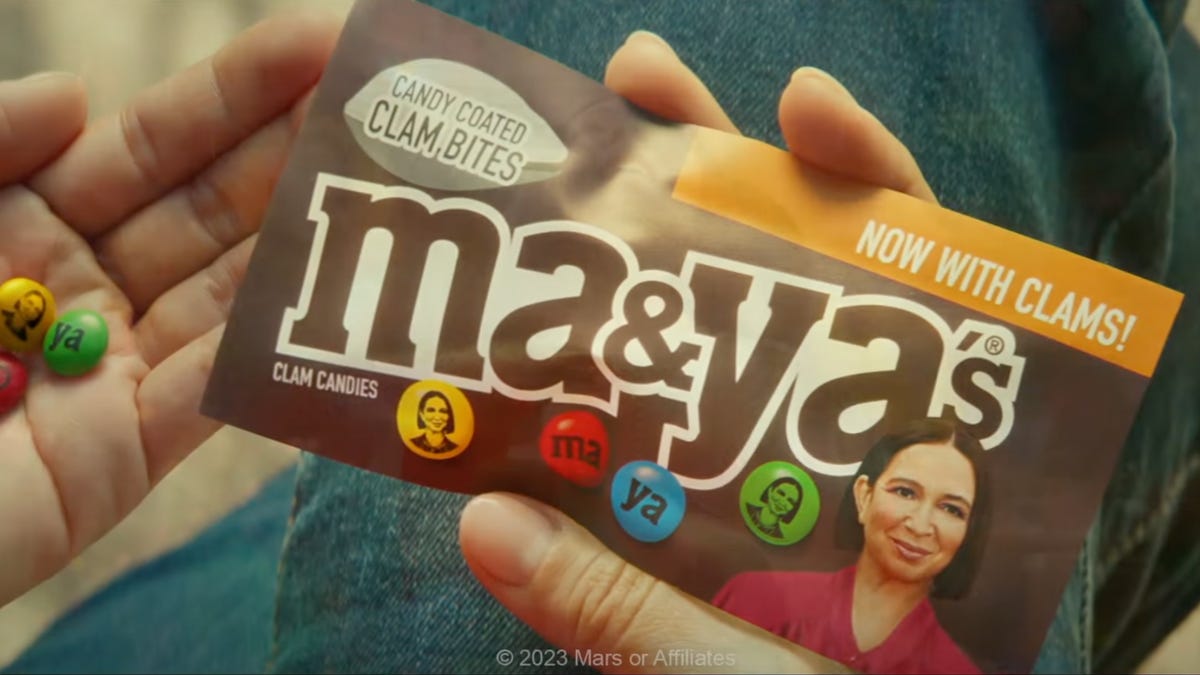The M&Ms and Maya Rudolph 'Controversy' Explained
The Super Bowl M&Ms "controversy" was actually just a publicity stunt. Mmm, chocolate-dipped clam bites...

Clams?
Who knew something as sweet and beloved as candy could cause controversy? In late January, M&Ms parent company Mars Wrigley pretended it was going to retire its goofy little googly-eyed cartoon mascots, known as "spokescandies." The company later confirmed it was all a Super Bowl stunt (one that went over about as well as a double doink off the goalposts in the last minute of the fourth quarter).
Then the plot thickened during the Feb. 12 Super Bowl, with an ad where new spokesperson Maya Rudolph pretended to announce a switch from the regular M&Ms chocolate candies to Ma&Yas clam candies.
Yeah, don't worry, the candy bites won't be replaced with stinky seafood treats anytime soon. But it's kind of a funny ad, with clams being dipped in chocolate in a supposedly enticing manner while Rudolph screams that people are supposed to like them. Meanwhile, the red M&M spokescandy shows up in the background holding a sign begging for help.
Near the end of the game, the spokescandies showed up again in a very short ad announcing, "They're back for good."
Publicity stunt exposed
"Rest assured, the characters are our official long-term spokescandies," a representative for Mars Wrigley told The New York Times on Friday. While "the iconic M&M's characters are in fact spending some time pursuing their other passions" ahead of the Super Bowl, the company noted that the Super Bowl ad would return "the characters right where they belong at the heart of the brand." And so it apparently did.
A representative for Mars Wrigley did not respond to a request for comment.
M&Ms original statement began, "America, let's talk." It went on to note that the colorful little candy mascots seen in the company's ads -- essentially, M&Ms with faces and limbs -- have caused internet controversy.
Therefore, the statement claimed, M&Ms "decided to take an indefinite pause from the spokescandies," instead adding actress and comedian Maya Rudolph as its spokesperson.
And then the Super Bowl ad threw chocolate-dipped clams into the mix, perhaps hoping the sheer weirdness of that idea would show the whole spokescandies switcharoo was all a big melt-in-your-mouth joke.
What are the 'spokescandies'?
Need some background on all this? M&Ms personified their candy years ago, giving each colored candy a different voice and personality in its ads. The yellow M&M, for example, is portrayed as kind of a dim bulb. He's a peanut M&M, so it might be a play on "peanut brain." The green M&M is portrayed as the sexy one, seemingly playing off an old playground joke about green M&Ms being little aphrodisiacs. The others all have slightly different personalities and appearances, and they pretty much stay consistent from ad to ad.
The candy has leaned hard on the spokescandies as part of their ad campaign. There's even an in-theaters ad showing the M&Ms as if they were characters in an action movie. It does double duty as a "turn off your cell phone PSA." Just as the candies are about to be sent into space strapped to a rocket, a phone rings, and they scold the audience for not turning their phones off.
Why are they controversial?
The fuss mainly surrounds the green and brown candies, depicted in ads as female. It started with their footwear. (Yes, these are still cartoon candies we are talking about.) The green M&M used to be drawn in high-heeled white go-go boots, and the brown M&M in stiletto heels. Then in 2022, green's boots were replaced with white sneakers, and brown went from super-high-heeled stilettos to a flatter, lower heel. (The male candies seem to all wear clunky white saddleshoes or sneakers.)
Back in 2022, Fox News host Tucker Carlson mocked the changes on his show.
"M&M's will not be satisfied until every last cartoon character is deeply unappealing and totally androgynous," Carlson said. "Until the moment when you wouldn't want to have a drink with any one of them. That's the goal. When you're totally turned off, we've achieved equity. They've won."
Tucker: M&M’s will not be satisfied until every last cartoon character is deeply unappealing and totally androgynous. Until the moment you wouldn’t want to have a drink with any one of them. That’s the goal. When you’re totally turned off, we’ve achieved equity… pic.twitter.com/rz7VtVCHWu
— Acyn (@Acyn) January 22, 2022
Carlson decided to attack the candies again in January 2023, also calling out the orange M&M for "becoming a poster boy for the mental-health crisis" (the always-nervous character was said to have anxiety). He described a purple peanut M&M, a newer character, as being an "obese and distinctively frumpy lesbian M&M."
Tucker Carlson comments on the M&Ms spokescandy scandal: pic.twitter.com/uz1baexser
— Kat Abu (@abughazalehkat) January 24, 2023
The purple, brown and green M&Ms, the only colors represented by female spokescandies, are offered together in a limited-edition candy pack that the company touts as supporting women, with a portion of profits going to organizations that are "uplifting and empowering women." A graphic shown on Fox called the all-female M&M pack, "woke candy."
Where have we seen this before?
This wasn't the first time a Super Bowl ad has teased at the removal of a company's mascot. In 2020, a big game commercial showed the funeral of Mr. Peanut, the mascot for Planters nuts, and the arrival of Baby Nut instead. (Baby Nut was aged up to adulthood, just like soap operas do, in 2021.)
And in 2019, the Mountain from Game of Thrones killed off Bud Light's mascot, the Bud Light Knight, in a Super Bowl commercial. He also returned to the world of the living in an ad shown just a few months later. So there's precedent for these ads yanking a beloved mascot away, then returning it to ads later on.

